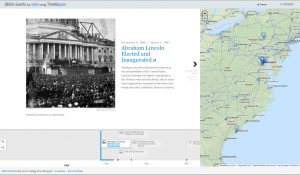“On Time”
Due Sunday 10/5 by 11pm
Thinking about how we represent history has been a question that has occupied us for millennia. Why does chronology of events matter? What can it show? How can we represent history? How do we “draw time”?
In “Time and Print,” Grafton observes that “Teachers and theorists claimed, over and over again, that chronology and geography were the two eyes of history: sources of precise, unquestionable information, which introduced order to the apparent chaos of events” (Grafton, p. 17) At the same time, the author points to Joseph Priestley, the 19th century scientist who believed that “historical narrative is not linear.” (20) So how do we reconcile linear and nonlinear time?
In the process of compiling your entries for the collective 1860s Timemapper and thinking about how time played out for Linn in his diary, how have you come to terms with the complex relationship between ideas and modes of representation? How does graphical representation clarifiy historical events? Where do we place Linn’s narrative within that representation? Where do the 1860s and Linn’s experience in winter 1862 fit together?
Write a 300-word blog post on this topic. Include at least three points from Grafton’s essay in your entry and at least two illustrative screen shots from Timemapper that illustrate your argument. Give your post the category “Blog #3” and at least five tags that help you to explain your work.
In addition, choose one of your classmates’ posts and give them feedback in the Comment box. Your comment should be 50-75 words in length and respond to a specific argument that is made in the post. For example, your comment might identify a correlation between your own post and one you see in your classmate’s work; it might introduce to the post’s author a different reading of something they interpreted in the Grafton essay; or it might reflect upon ways in which you both consider Linn’s experience within a larger chronological landscape.
